August Monthly Commentary
July was a dynamic month for U.S. equities, marked by significant rotation within the market. We observed a pronounced shift away from big tech, growth, and momentum stocks towards value, cyclicals, and small caps. This movement was initially sparked by a cooler-than-expected June Consumer Price Index (CPI) report.
The Magnificent 7, which had been major drivers of index performance throughout the year, experienced sharp pullbacks before stabilizing near the end of the month. In this environment, the equal-weighted S&P 500 (RSP) outperformed the official index by 333 basis points, achieving its largest margin since February 2021. The small-cap Russell 2000 also had a notable performance, logging its best month since December with a 10.1% gain, bringing its year-to-date performance to 11.2% through the end of July.
WealthTrust Long Term Growth Portfolio July Top 10
Sector Performance and Market Drivers
The outperformers in July included homebuilders (XHB +16.9%), driven by a decline in 30-year mortgage rates to their lowest levels since March. Other areas of strength included regional banks (KRX +18.6%), credit cards, insurers, managed care, media, aerospace and defense, building materials, biotech, utilities, and retail/office REITs. Within the Magnificent 7, TSLA (+17.3%) and AAPL (+5.4%) were the exceptions, showing positive returns.
Our rotation from technology into the Russell 2000, defense industry participants(cyclicals) and the Equal Weighted S&P 500 while increasing our exposure to Cash and Gold has helped support our strategies during the aforementioned market rotation.
Conversely, sectors such as semiconductors, software, airlines, department stores, restaurants, travel and leisure, apparel, and entertainment lagged.
Treasuries saw broad gains as market participants continued to expect the Federal Reserve to start a rate-cutting cycle in September. The 2-year yield ended the month near its lowest point since February, and the 2/10 spread hit its least inverted point since July 2022. The U.S. dollar weakened against major currencies, with the DXY down by 1.7%. Gold (+5.7%) and copper (-4.3%) continued to reflect concerns over global economic conditions, particularly in China. Meanwhile, WTI crude oil (-4.5%) declined towards its June lows, though tensions in the Middle East provided a late-month boost.
Key Market Events and Themes
The S&P 500 began July strongly, bolstered by solid earnings expectations and positive seasonality, with significant help from big tech. However, the cooler June CPI report released on July 11 prompted a rotation out of growth and momentum stocks. This report marked the first headline decline since July 2022 and indicated a softer core rise, with a deceleration in sticky shelter prices.
The cooperative inflation readings enhanced market expectations for the Fed to start a rate-cut cycle in September. Although the Fed's July 31 FOMC statement did not explicitly hint at this, it did acknowledge that inflation remains "somewhat" elevated and emphasized attentiveness to labor market risks. Fed Chair Powell mentioned that a rate cut could be on the table as early as September, but stressed the data-dependent nature of their approach.
AI, a central market driver in recent months, faced scrutiny regarding the balance between capital expenditure ramps and slower monetization. Earnings reports continued to be critical for assessing consumer health. While June retail sales remained robust, corporations flagged signs of stress beyond low-income cohorts.
Corporate Highlights
July was a busy month for corporate updates with the start of Q2 earnings season. By the end of the month, nearly 57% of S&P constituents had reported, with a blended year-over-year earnings growth rate of 10.2%, surpassing the 8.9% expected at the end of the quarter. Over 78% of earnings reporters announced positive surprises, averaging approximately 4% above consensus, though this beat magnitude was below historical averages.
Notable gainers included Charter Communications (CHTR +27.0%), 3M (MMM +24.8%), Sherwin-Williams (SHW +17.6%), Bristol-Myers Squibb (BMY +14.5%), Tesla (TSLA +17.3%), Raytheon Technologies (RTX +17.0%), and UnitedHealth Group (UNH +13.1%).
On the downside, Eli Lilly (LLY -11.2%) faced pressure amid GLP-1 competitor updates, Charles Schwab (SCHW -11.5%) reported soft June operating metrics, Ford (F -13.7%) had a significant earnings miss due to warranty headwinds, Pinterest (PINS -27.5%) flagged advertising softness, CrowdStrike (CRWD -39.5%) was hit by a global cybersecurity incident, and Dexcom (DXCM -40.2%) lowered FY guidance due to U.S. execution missteps.
Sector Performance
- Outperformers: Real Estate (+7.11%), Utilities (+6.73%), Financials (+6.31%), Industrials (+4.84%), Materials (+4.31%), Healthcare (+2.49%), Energy (+2.03%), Consumer Staples (+1.77%), Consumer Discretionary (+1.64%)
- Underperformers: Communication Services (-4.16%), Technology (-2.12%)
Looking Ahead
As we move into August, the market's bullish case remains anchored in disinflationary progress, anticipated Fed rate cuts, firm soft-landing hopes, solid earnings prospects, and continued inflows. While AI optimism persists, tempered by scrutiny, there are rising concerns about consumer pressure and a weakening labor market which should support lowering interest rates sooner rather than later. This should benefit interest sensitive sectors and asset classes such as technology, housing, and small caps.
We will continue to monitor these developments closely and adjust our strategies accordingly to navigate the evolving market landscape.
Hope you have a great August.

